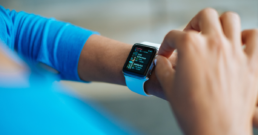Your Heart Rate: Indicator for Health and Fitness
You’ve probably noticed that your wearable fitness technology is monitoring your heart rate—but have you ever wondered why? There’s a direct relationship between your heart rate and your workout’s intensity.
Resting Heart Rate
As the name suggests, your resting heart rate is the number of times your heart beats per minute (bpm). While your resting heart rate can vary daily, the typical range is 60-100 bpm. Improving your cardiovascular health can reduce your resting heart rate.
Heart Rate and Exercise
When you’re working out, you should strive to keep your heart rate within a target heart rate zone. This target heart rate zone is 50%-85% of your maximum heart rate. To calculate your maximum heart rate, subtract your age from 220. From there, you can find out your target heart rate numbers by multiplying your maximum heart rate by your target heart rate percentage. Once you’ve calculated your maximum and target heart rates, you can use these numbers to monitor your workout’s intensity and track your fitness.

Heart Rate Zones
Threshold Zone – 80% – 90%
Aerobic Zone – 70%- 80%
Endurance Zone – 60%- 70%
Recovery Zone – 50%- 60%

Nutritional Information (per serving)
| Total Calories | 62 |
| Total Fat | 0 g |
| Protein | 1 g |
| Carbohydrates | 15 g |
| Dietary Fiber | 1 g |
| Saturated Fat | 0 g |
| Sodium | 22 mg |
| Total Sugars | 15 g |
Source: USDA
Fruit Slush
Ingredients
- 2 ⅔ cups cantaloupe or watermelon (coarsely chopped, peeled, seeded)
- 1 ⅔ cups kiwi (peeled, chopped)
- 2 Tbsp. sugar
- 2 Tbsp. lime juice
- 2 cups water
- Ice
Preparations
- In a blender, puree fruit with sugar and lime juice until smooth.
- Combine fruit mixture and water in a large pitcher.
- If desired, pour through a strainer to eliminate pulp.
- Cover and refrigerate for up to a week.
- To serve, stir well and pour into tall glasses over ice.
Makes: 4 servings
This article is intended for informational purposes only and is not intended to be exhaustive, nor should any discussion or opinions be construed as professional advice. Readers should contact a health professional for appropriate advice.

